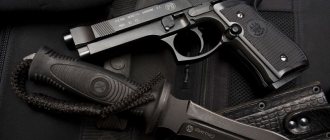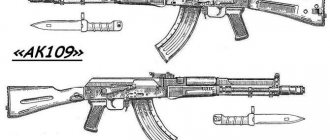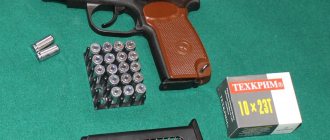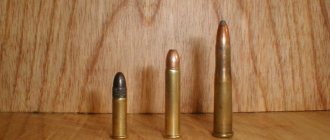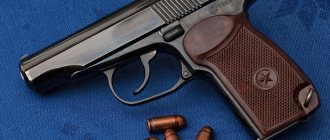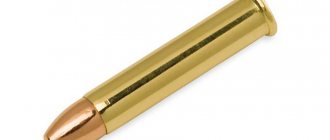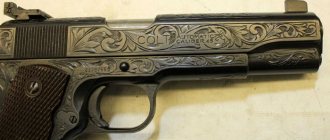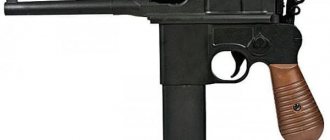Description of the Guardian starting revolver
“Guardian” was manufactured at the famous Izhevsk Mechanical Plant from 1992 to 1996. It was one of the first signal pistols in the Russian Federation. To date, production of the model has been discontinued due to frequent cases of alterations.
The body and barrel are made of silumin and joined together using precision casting. The trigger is made in the form of a square frame with a protruding part for the mainspring and pusher. The trigger is without self-cocking, made in the form of a solid removable block and fixed by the drum axis in the housing. The drum is made of steel and can be removed for loading.
The trigger mechanism frame is inserted into the pistol body from above, through a slot above the drum. The frame is secured with a screw at the back of the handle. He presses the frame to the body and locks it in the desired position. The trigger strikes the cartridge on the side, rimfire.
The design of the "Guardian" is simple, the hammer is single action, it must be cocked manually for each shot. If the hammer is not cocked, pulling the trigger rotates the cylinder to the next round.
On the left side of the frame there is a manufacturer's mark - a vertical arrow in a circle. On the barrel there is the inscription “Guardian” cast along with the part.
In the summer of 2011, amendments to the Weapons Law, approved by the president, came into force. According to these amendments, the conversion of military weapons into pneumatic and signal weapons is prohibited. Now some types of weapons that were created by deactivation from combat samples can only be seen in museums and in pictures in articles like this. What did airgun lovers, collectors and other weapon admirers lose as a result of these measures? First of all, these innovations affected the production of signal revolvers, created on the basis of the famous revolvers of the Nagant system of the 1895 model. It was discontinued. Typically, these revolvers were always available in any gun store, both in those that sell firearms and hunting weapons, and in many online stores of air guns. Because these revolvers are quite recognizable, and besides, neither permission nor a license was required to purchase them. Therefore, every adult who likes revolvers could purchase an interesting model of a signal revolver for his collection. In general, a revolver is a special thing. Its very name has become a household word, and many people who are little familiar with weapons identify the designer’s surname - Nagan - with all revolvers.
Perhaps the generation born in the Soviet Union has particular respect and interest in revolvers of the Nagant system, since the Nagant was an invariable attribute of films about the revolution, the Civil War or the Patriotic War. Reading Arkady Gaidar or other books about the times of the Civil War, the boys imagined themselves with the legendary revolver in their hand. Modern youth are less interested in the events of that time and perceive them differently, but even now films are appearing where the action takes place at the beginning or middle of the last century. For example, in the post-war 40s of the twentieth century, when the restoration of the country began and the liquidation of proliferating gangs was underway. Revolvers were often used as weapons on both sides. Many men are interested in weapons (and childhood impressions are the most vivid), so many people would like to hold historical weapons in their hands. Signal revolvers were precisely manufactured by deactivating them from combat revolvers. Nagan system revolvers have long been withdrawn from service and were used as service weapons only in some paramilitary security services. In total, more than two million units of such weapons were produced in Russia, and they lay idle in military warehouses. They tried to send them to be melted down. To do this, the revolvers were first flattened under pressure, and then these “pancakes” were melted down.
In 2006, the conversion of combat revolvers of different years of production into signal samples began. Production began at Vyatsko-Polyansky. The revolver was released under the Nagan-S brand, but received the trade name “Bluff”. After him, other factories produced signal revolvers R-2 and MP-313. These revolvers have the original manufacturer's stamps indicating the year of manufacture. Production began precisely from the early years of production, so the so-called “imperial revolvers” produced before the 1917 revolution, and even those assembled at the end of the 19th century, went on sale. Back then it was still possible to select or order a revolver of a certain year of manufacture. Now, almost all of these early samples have already been sold out, and they can only be purchased by hand. But before continuing the conversation about the signal variants of the revolver, let's turn to the combat prototype of this air weapon. The city of Liege in Belgium was one of the European centers of the arms industry. Since 1859, a small family workshop of Emil and Leon Naganov operated there, which repaired revolvers. Some time later, they began to design their own firearms, and the workshop turned into a weapons factory. It was Leon Nagan who became the designer of the legendary revolver, which later received his name. In general, Nagana created several revolvers of different designs, or rather, there were several variants of the same design before the model we are accustomed to appeared. But they all had common features: a double-action trigger mechanism, which allows you to shoot both self-cocking and with pre-cocking. The exception was the so-called “soldier” pre-revolutionary models - they could only be fired with preliminary cocking. The revolver mechanism, which is located in the frame, is closed with a flat lid. The revolver frame is monolithic and one-piece. The barrel is screwed into the frame and seated tightly. The drum chambers are opened by a door that opens by turning to the side. After firing, the ramrod plays the role of an ejector for spent cartridges, and in the firing position it is located in the axis of the drum.
Revolver disassembly diagram
But we are interested in precisely the version of the revolver that was already produced and used in Russia. How did the Nagant revolver get to Russia? At the end of the 19th century, the Russian Empire, like many other European states, began massive rearmament of the army. A commission was involved in the search for promising models, and a competition was announced for a model of a new revolver for the Russian army. The requirements for the new army revolver were as follows: • The design of the revolver must be simple and technologically advanced. • The weight of the weapon should be small (approximately 0.82-0.92 kg). • The bullet must have great stopping power. • Penetration power should also be high. The bullet should penetrate four or five pine boards, one inch thick. • Initial bullet speed of at least 300 m/s. • The revolver must provide good accuracy of fire. • The caliber of the weapon, the rifling profile, and other characteristics of the barrel must match those of the Mosin rifle, so that defective rifle barrels can be used in the production of revolvers. • The revolver should not have self-cocking firing, as it was believed that this would have a bad effect on accuracy. • Weapons must be reliable and easy to use. The revolver must be insensitive to poor operating conditions and contamination. • The drum must hold at least 7 rounds. • Extraction of cartridges should be carried out one by one, and not simultaneously. Leon Nagant took part in the competition. He converted his revolver to the Russian caliber 7.62 mm, and in accordance with the terms of the competition, excluded the possibility of self-cocking shooting. We won’t get into the behind-the-scenes intrigues of that time, but it so happened that the winner was a revolver designed by Nagant. By the way, as a result of military tests, the officers who took part in them expressed a desire to receive a revolver with the ability to fire by self-cocking. However, the commission did not consider the self-cocking version of the revolver to be completely satisfactory. As a result, they decided to arm the army with two types of revolvers. One is an officer's one - double action, the second is a soldier's, firing only from a preliminary cocking.
Combat revolver
A number of minor changes were made to the design. By decree of Nicholas II of May 13, 1895, the Nagant revolver was adopted by the Russian army. The contract provided for the supply of revolvers from Belgium over the next three years in the amount of 20 thousand pieces. Then its own production was organized at the Tula Arms Plant. In Russia, the design of the revolver was slightly modernized. The shape of the front sight was simplified and the back of the handle was made solid, and not split, as in the Belgian model. Of course, the revolver production technology has also been improved. Since then, the history of the Russian revolver began, which is known under the name “Nagan” model 1985. The revolver was distinguished by its relative simplicity of design, manufacturability and, importantly, low cost. One can also note the good maintainability of the revolver of this system. In combat conditions, the main advantages were its reliability and ease of operation. Even a misfire did not affect the firing of the next shot and did not cause a delay. The Tula Arms Factory produced Nagant revolvers during the Civil War. Mass rearmament of the Red Army began after 1930, when the TT pistol was adopted. However, the Model 1895 revolver still continued to be produced. The design and production technology underwent only slight modifications: a semicircular truncated front sight shape was introduced, and the sight slot became semicircular rather than triangular.
During the Great Patriotic War, the production of revolvers continued both in Tula and at the Izhevsk plant, where the Tula Arms Plant was partially evacuated. And although the advantages of the pistol were clear to the army leadership, the production of revolvers did not stop until the end of the war. True, during the war the quality of their manufacture and finishing deteriorated. The defect rate increased due to a lack of qualified personnel and because the quantity of weapons produced was enormous, and this could not but affect the quality. After the war, the Model 1895 revolver was withdrawn from service and, accordingly, its production was discontinued. Even before the mid-50s of the 20th century, revolvers were in service with the police. For even longer, Nagant system revolvers were used in cash-in-transit service and in paramilitary security. So, we briefly talked about the historical path of the revolver known as the “revolver”. In fact, there are a lot of interesting things both in the history of creation and in the history of combat use of revolvers. Therefore, for many weapon lovers, and especially fans of revolvers, holding a revolver in their hands means not just feeling the steel of a military weapon, but also literally touching a certain period of history. Now let's return to signal revolvers, the basis for which was combat weapons. But first, let’s see what the design of a Nagant system revolver is: the revolver’s drum serves as both a magazine and a chamber. The drum capacity is 7 rounds. The drum is equipped with a return mechanism, since when the revolver is cocked, the drum moves onto the barrel. It consists of a spring and a drum tube and returns the drum to its original position. The drum has a hollow axle, which is inserted from the front into the frame of the revolver and held in place by a ramrod tube. This tube is installed in front of the drum and is attached to the neck of the barrel. It has the ability to rotate on the barrel, as if on an axis, so in one of the positions the ramrod is used to push cartridges out of the drum chambers. On the right wall of the revolver frame there is a spring-loaded door, which plays the role of a locking device for the drum. When tilted to the side, the door allows you to load and unload the revolver. When closed, the door closes the chamber, thereby preventing the drum from turning counterclockwise and preventing the cartridge from falling out. The drum has seven slots for the door protrusion in the open and closed positions. The revolver mechanism consists of parts that perform the functions of the trigger mechanism, and also rotate the drum and slide it onto the barrel.
When converting revolvers into signal samples, the changes did not affect the main design and mechanism of the revolver. Moreover, revolvers are not just mass-sized models, but they can be used to fire noise. Zhevelo-type capsules are used as ammunition. The appearance of the revolver is practically preserved; such a revolver is disassembled and serviced in the usual way. As we noted at the beginning, three versions of signal revolvers were released, “Bluff”, MP-313, and R-2. Each individual revolver was manufactured, or rather, redesigned at different factories. Bluff (VPO-503) was produced at MR-313 (Nagan-07) at FSUE Izhmekh, and R-2 at the facilities of the IzhMash concern. Thus, each of the famous arms factories was able to give the revolver a second life. Accordingly, each revolver was deactivated in its own way. Let's look at some of the features of each deactivation option.
Signal revolver "Bluff"
The “Bluff” revolver has a barrel drilled to a diameter of 11.5 mm. The chambers of the drum are converted to the caliber of the “jevelo” capsule, that is, on the trigger side, bushings for the capsule are pressed into the drum. There are grooves in the area of the barrel breech. The barrel is completely sealed from the breech - a plug is installed there. The number is stamped on the frame with the barrel. The numbers on the drum, frame and some other parts usually match. The Nagan-S was produced from 2006 to 2008, and back in 2010. At the Izhevsk Mechanical Plant, the MP-313 revolver was deactivated in a slightly different way. There is not a plug installed in the barrel, but a cone-shaped divider. As a result, gases escape from the barrel when fired. The barrel itself is not very bored. In fact, only the rifling is removed from it. The frame at the breech of the barrel has not been grooved. However, the cylinder number does not match the internal number on the revolver frame. On the outside, on the frame itself, the number is ground off. The drum of the MP-313 is bored out, and the bushings for the capsules are not pressed in, but screwed into threads. The R-2 revolver retains the rifling in the barrel. The plug is made in the form of a pin, which is inserted into the barrel on the right side of the frame. This place is welded and sanded. There are revolvers where the pin completely covers the barrel, and there are examples where there is a gap for gases to escape when firing. On the P-2 frame the number is stored and it matches the drum number. There are no new-made inscriptions on the back of the frame or on the drum. The drum is drilled out and inserts for the “jewel” are installed in it. The handles are mostly black plastic, although brown bakelite ones are also available. The R-2 was made mainly from revolvers of later years of production. Ideally, it would be nice to have a revolver with a barrel from the R-2, a splitter in the barrel from the MP-313, and a drum from the “Bluff”. And so that the numbers of all parts match on the marking. Then there would be the most natural and closest to the combat model option. But in principle, each model has some advantages. The Bluff would be of interest to collectors as there were early variants available and all the part numbers match, indicating that the revolver is a complete historical example and not assembled from a collection of components. The R-2 attracts with its authenticity and will be of interest to those who value a strong external resemblance to a combat revolver. The MP-313 can be recommended to fans of “bab-hunting”, since it has the most natural sound from a shot due to the unmuffled barrel.
Signal revolver MP-313
Therefore, you can be content with the samples offered by manufacturers. Moreover, soon all variants of signal revolvers will disappear from sale. In the January news of Izhevsky Arsenal LLC from 2011 you can read: “Izhevsky Arsenal LLC bought the last batch of Izhevsk-made signal weapons MR-313. Neither the Izhevsk Mechanical Federal State Unitary Enterprise will resume production of signal revolvers. Amendments to the Weapons Law adopted by the President prohibit the conversion of military weapons into signal and pneumatic weapons. In conditions where Izhevsky Arsenal LLC has already completed wholesale sales of R-2 signal revolvers, the purchased MP-313 signal revolvers will be enough for sale for no more than 2 months.”
Perhaps in the future there will be modern replicas of revolvers in the form of pneumatic or signal weapons. For example, foreign-made pneumatic TT and airsoft PPSh are already on sale. And although the new revolvers of the Nagan system may turn out to be very similar to combat models, all the same, when communicating with them, their owners will no longer have the same feeling of a living connection with the historical past.
(material taken from the Internet) =))
Specifications
The revolver fires light-sound cartridges with a diameter of 5.6 mm and Zhevelo capsules. A pin is installed in the barrel by the manufacturer. Designed for signaling at sporting events, can be used for entertainment purposes. The magazine holds 7 rounds. The revolver weighs only 360 g. Length 12.3 cm, thickness 2.6 cm, height 11 cm. The barrel is short, which makes the model compact. The handle is long and comfortable. Cover color is black.
Signal revolver LOM-S
Date: 06/07/2019
Hello, dear readers! Today in our review is a small embodiment of my childhood dream from films - a revolver, namely, I am holding in my hands a LOM-S signal revolver manufactured by Zoraki (Turkey) - a loud automatic action. It is the market leader in terms of shot volume. The volume is mainly ensured by the use of mounting sockets. The revolver is stylish and realistic. It will be a good gift for any man; the gun can be used for self-defense, as well as for scaring away wild animals. I propose to look at it in more detail... what a revolver looks like in life.
You can see it in the photo above. The revolver looks very solid. If you pre-cock the trigger, the shot is easy. The body and mechanisms of the weapon are made of metal, and plastic is used only on the handle pads. Also, for safety, the product is covered with black bluing, as in the photo above, and chrome if the gun is light in color. Below you can look at the photo and the second option, or follow the links and make a choice for yourself which one you like more. I personally like both.
If you are wondering: can it be converted into a combat weapon, then the answer is no! It's easier to make a new one. )
According to some characteristics, the length of the revolver is 186 mm, the barrel length is 63 mm with a total weight of 750 g. Yes, the revolver is sold without a license or registration.
The LOM-S revolver has a double-action trigger mechanism. Those. allows you to shoot from a pre-cocked hammer or self-cocking. The pistol fires construction cartridges of 5.6x16 mm caliber, namely, with a brown head. If you use anything other than them, you can get the drum bloated. The drum holds 9 rounds. The trigger is quite easy to press. As for the initial speed of the signal, it is equal to 115 m/s.
Below we can take a closer look. To fold the cylinder, you can easily press the button on the left side of the revolver. And in order for the drum holding mechanism to be released, you only need to push this button forward. To return the drum to its place, you simply need to return it to the revolver frame until a characteristic click is heard and turn it around its axis to make sure that its axis coincides with the axis of the barrel and the drum is firmly fixed.
In the photo you can see: all the details of the LOM-S signal revolver look decent, expensive and very high quality, and if we remember that it is loud, then all these qualities as a whole make this model very similar to a combat pistol.
The cartridges that have been shot are easily thrown out of the drum when you press the rod, and you can perform this action with one hand.
I would like to note that the package includes a threaded attachment for rockets, which is screwed into the barrel of the pistol. This means that you can use the gun for flares. The barrel of the gun has a thread for the martira (nozzle). It has 2 channels for removing excess powder gases located on the sides of the base. Can also be used for special mini fireworks. When setting off fireworks, make sure that they burn completely and that you do not create a fire situation, as these fireworks do not burn completely in the air.
When checking, it was clear that the LOM-S revolver shoots quickly and is easy to reload, everything is convenient, compact and comfortable. All you need to shoot quickly and consistently is how fast you pull the trigger.
I will add that it is very pleasant to hold this revolver in your hand; this is facilitated by its small size, rubberized grip and cutouts on the handle.
The robust, modern design meets high safety requirements. I would like to note that the LOM-S signal revolver is excellent for teaching initial skills in handling weapons. I also find it to be a reliable companion in many situations.
Comments for the site
Cackl e
Advantages and disadvantages
Despite the fact that the revolver is made from not the most durable materials, practical use has shown that it is quite reliable. The weapon's lifespan is sufficient for its intended use; often samples of the model have not yet failed and fire properly. The “Guardian” was widely used for its intended purpose - to give a start signal at sports competitions. Due to the simplicity of the design, the Sentinel revolver is easy to repair, easy to repair or replace parts with simple shapes.
Disadvantages: due to the fragility of the metal, the drum gears quickly wear out, it does not rotate correctly, the cartridge does not reach the firing pin, which leads to a misfire. There are problems with the drum pawl; during disassembly, when removing the trigger frame, it can jump off. The frame and parts of the trigger are made of a soft metal alloy and are not always reliable. Often the appearance of a revolver suffers due to easily erasable paint.
RS-22 "Guardian" is designed to provide sound signals. It was the first publicly available model of a signal weapon and was very popular in its time. On the basis of the model, the RG-22 gas pistol chambered for a 5.6 mm cartridge is manufactured.
Restoring cold and signal weapons part 2.
@TheBlackWeb
All information is for informational purposes only and is not intended as a guide to action.
Difficulty level 1. On the knee, with the help of plumbing tools and with minimal skills
Here we have collected the simplest things that can be restored, and what is important - for an affordable cartridge, which can also be loaded on the knee using light-sound, blank or construction cartridges, which are freely available in gun stores, as sources. To do this, you will need metalworking tools and skills to work with them at the level of a trade lesson in the sixth grade. You don’t even have to make a barrel, a 5.5mm pneumatic barrel, which is ideal for small-caliber weapons, even a rifle, even a pistol, can be easily bought on pneumatic forums and the purchase of such a barrel does not cause a flaw, unlike the purchase of a 9mm rifled form, because for storing a large pneumatic weapon caliber and increased power - just an administrative fine.
Large-caliber Nagant:
Criteria for choosing a Nagant: it is not recommended to buy a Nagant and, in general, USSR weapons produced during the war years, namely 1941-1945, since the weapons were manufactured in a terrible hurry. Due to the war and wartime regulations, the manufacturing quality of WWII weapons is worse than those produced in peacetime.
For work we will need:
- Nagan Signal MP-313
- Hammer, electric drill, drills, vice, wrench, electronic caliper
- Reamers 8.5, 9.0, 9.5 mm or others for the required caliber
- Reaming the chamber 9x18 or for the desired caliber
- 9mm conical countersink with long and thin shank
- Optional: 300 sandpaper and hone, trellis planer 9.25mm or to the desired caliber
Step 1 - Removing the divider:
We disassemble the MP-313 completely; we see a splitter in the barrel from the breech. It is secured there by welding - a hole is drilled through the side of the frame and it is welded through it, there are no pins there, and it is often tacked on in an obscene manner. The barrel is therefore not removable. We rest the Nagan with the front of the frame against something strong, but not metal, so as not to bend the frame, insert a rod into the barrel and apply several heavy blows with a hammer. On the fifth blow, the splitter flies out. If you're unlucky and the splitter is welded securely and doesn't fly out after a dozen hits, you don't need to take a sledgehammer. The frame of the Nagan is not strong, so in this case we drill out the splitter with a new or well-sharpened 8.2 drill (according to the diameter of the barrel bore). If you are too lazy to tinker with the barrel and shoot traumatic or buckshot with homemade cartridges, you can immediately move on to the point, the barrel can already perform its functions.
Step 2 - Barrel Calibration
We unfold the barrel with an 8.5mm reamer, then 9mm. We unfold it very carefully, slowly, avoiding scuffing and shake out the chips after every 5mm. After reaming, we optionally hone: since we cannot start the hone from the treasury, we start it from the muzzle. We hone a little, literally a couple of holes five times back and forth, because a bell can form - and goodbye, accuracy and good penetration. It's better not to hone if you're not sure. Important! If you do mess up the barrel with a scratch or a shell, forget about it and don’t try to smooth it out with sandpaper. The shell will not affect the fight, and the bell will be guaranteed during long honing. Next, if desired, we cut the trunk with a trellis, 6-8 cuts are enough. Important! The planer must be carbide, tested, well sharpened and pierced with a medium hammer, not a sledgehammer, so as not to bend the frame. Next, we use a conical countersink: we insert the shank into the breech window, and the countersink into the barrel from the breech and remove the deep chamfer so that the bullet enters the barrel smoothly. Then we polish the chamfer using the same method using a rubber abrasive cutter for a dremmel or a hone. Don't forget to chamfer and chamfer the muzzle. The frame with the barrel can be blued and assembled, it is ready.
Step 3 - Reworking the Drum
Inserts with a diameter of 10 mm and the same length are inserted into the drum, mounted on a thread. You can’t knock them out, and it’s difficult to get them out without a slot. Therefore, we drill them from the back with an 8mm drill; as soon as the drill engages, the insert will unscrew. Next, we go through each chamber by reaming the chamber so that the cartridge is buried in it flush with the drum, this depth for any caliber without a flange that you will use in a Nagan revolver, the cartridge case will be fixed by the bullet entrance of the drum. Next, using a 9.5mm reamer, we go through the remaining part of each chamber, but not through it, only through the leading part of the reamer, where the diameter is 9.3mm, this is necessary so that the bullet does not overcompress in the drum. We polish the chambers, if necessary, the cartridge should freely fall out of the chamber under its own weight. Check only with an unfired or strictly calibrated cartridge. We burn, we collect. The large-caliber Nagant is ready, you can shoot it.
Small-caliber Nagant
For work we will need:
- Nagant Bluff
- Electric drill with 13mm chuck and drill bits
- Hammer, vice, wrench, electronic caliper
- Reamers 9mm, 5.6mm - if you can’t find them, you can use a drill
- Reaming a 5.6mm chamber with a working part for a flange
- A piece of 5.5mm pneumatic barrel of sufficient length with a diameter of 12-13mm
- Bushings 9.05X37mm with an internal diameter of 5mm, any steel, order from a turner
Step 1 - Rebuilding the Barrel
We disassemble the Bluff, in the upper part of the frame, just above the weakening cuts on both sides, we erase the bluing with fine sandpaper until we see a trace of the pin with which the barrel and the plug in it are pinned. Punch and carefully drill out this pin. The frame in these places is weakened, so there is no need to knock out the pin. After removing the pin, loosely unscrew the barrel and knock out the plug from it. In a drill, we grind our pneumatic blank to the inner diameter of the Bluff barrel, so that it fits there with some interference. Immediately cut the thread for the muffler, if necessary. We press the turned liner into the deactivated barrel of Bluff, process it if necessary. From the breech we make a conical approach, from the muzzle - a chamfer. The stem is ready.
Step 2 - Drum Restoration
We prepare the bushings ordered from the turner: we remove the chamfers, unroll the cartridge using a reamer, and make a recess for the sleeve flange. The sleeve should fit flush into the sleeve; the sleeve flange should not stick out. This recess can be made either by reaming the chamber, or by any reaming with a pilot, or, as a last resort, with a re-sharpened drill. The inserts in the drum are pressed, they are seated quite tightly. To knock it out you need a strong pin, a heavy hammer and some kind of backing so as not to damage the drum ratchet, or a large vice. You will have to hit them hard, if you don’t want to do this, then it’s better to drill them out. We remove the bushings, drill out the chambers with an 8.7mm drill, and turn them all the way through with a 9mm reamer. We press the bushings into place into the drum, accurately checking their positioning - they must be strictly flush on the breech side. I forgot to write - if you press with a hammer, press through the brass lining. All that remains is to fasten the bushings - we drill each chamber from the side with a 3.3mm by 5mm drill bit in depth, cut the M4 threads with the first and second taps, screw the M4 bolts onto the thread lock or glue until they stop, cut off the protruding parts of the bolts and process them with a file. That's it, the drum is ready, the chambers are not going anywhere. Let's black it out.
Step 3 - Assembling the Revolver
We screw the barrel into the frame, go through the hole where the deactivation pin was with a 2.5mm drill, cut an M3 thread and screw the screw onto the thread lock. You can install a new pin, similar to the principle of fixing the AK barrel, but a screw is better, because the thread will additionally fix the weakened sides of the frame. We burnish and assemble the frame. The original breech is not suitable for side firing, and it is very difficult to remake it without welding, so we simply buy a new-made breech with a firing pin for side firing, in my opinion from the Nagant Smirnsky. We install a new breech, firing pin, and assemble the revolver. The first time - we click the idle exactly seven times and remove the drum. We see work hardening at the border of the recesses for the case flange: the firing pin is designed to hit the rim of the case. We drill out this self-core with a 2mm drill to the depth of the groove under the flange, this is necessary so that the firing pin does not die after a couple of fired drums. The small-caliber Nagant is ready.
Stalker M906 .22Short, .22Long Rifle
Here is a Turkish compact signal pistol chambered for the cartridge beloved by many remodelers. It is made from TsAM, but from a fairly good grade, and as practice shows, it can still be restored in .22 caliber - this is probably one of the most convenient, compact, inexpensive and easily restored machines.
Selection criteria: if you don’t want to face difficulties after restoration and wonder if it’s your gun or the gun, it’s better to buy a new gun. Fans of drunken noise and experimentation may well lead a modern TsAMoplastic pistol to a state of partial breakdown and then sell it to someone. This is still not a Nagant or a PM, in which only bakelite is subject to accidental breakdowns; everything else can only be broken purposefully and with great difficulty.
For work we will need:
- Drill, drills, reamers
- M10X1 tap and die
- Dremmel with attachments
- Vise, hacksaw, hammer
- Reaming the .22LR chamber
Step 1 — Dismantling the idle barrel
We completely disassemble the pistol. Inside the barrel there is a liner with a divider, made of very good and hardened steel. We don’t even think about drilling it out - the drill will come out through the side, we don’t need the outer shell of the barrel from TsAM either. We cut off the old stem along the most rectangular post, from it we will make a fastening coupling, as on the PM. There may be problems with cutting the stem - if you don’t have a grinder, the heated liner is very difficult to use with a hacksaw. We change blades, saw and saw, but we don’t even think about breaking, the TsAM will break faster than steel. After cutting, we drill out a steel isthmus from the treasury between the chamber and the divider. The steel there is hardened, an ordinary drill takes it with great difficulty, it’s better to drill with a Soviet hammer on concrete with a pobedit tip, after sharpening it, such a sharpened drill cuts the hardened steel like butter. You can resharpen a drill bit for a hammer drill. After drilling, carefully knock out the remaining liner from the chamber side.
Step 2 - Installing a new stem
We drill out the barrel coupling with an 8.9mm drill and cut an M10x1 thread in it with taps. A fine thread pitch of 1 mm is needed for good load distribution and, consequently, the durability of the device. We grind a piece of a 5.5mm pneumatic barrel in a drill to a diameter of 9.05mm for the length of the coupling, and cut the same thread on it with a die. If desired, unfold the barrel and grind and cut a thread on it for the muffler. We unfold the chamber in the barrel - the depth is such that the flange of the cartridge case sticks out. We screw the barrel into the coupling, adjust it, and check the alignment. If everything is fine, screw the barrel onto the thread lock; you can pin it if desired. We make recesses for the ejector and form a feed slide. That's it, the gun is ready, the next step is optional.
Step 3 — Finalizing the store
Without modification, only the .22Short cartridge, or a homemade cartridge based on the mounting 5.6, with a bullet instead of a sprocket, will fit into the magazine. What if you can get a full-size .22LR? The store needs to be remodeled. To do this, we disassemble the magazine, remove all the stops with a Dremel and grind a new feeder out of a piece of plastic. I’ll say right away that even with all the manipulations, the factory 5.6LR cartridge has difficulty fitting into the magazine, so you will have to file off the bullet nose a little on all cartridges. Important! For especially evil cartridges, you may have to install a spring from the Shark traumatizer; a damper is not needed here, the .22 cartridge does not have such a strong impulse.
ATTENTION! Illegal manufacture, alteration or repair of firearms, their main parts (with the exception of firearms of limited destruction), as well as illegal manufacture of ammunition, IS A CRIMINAL OFFENSE AND IS PROSECUTED UNDER THE LAW Article 223 of the Criminal Code of the Russian Federation.
ALL INFORMATION IS WRITTEN FOR INFORMATION PURPOSES AND DOES NOT CALL TO ACTION.
